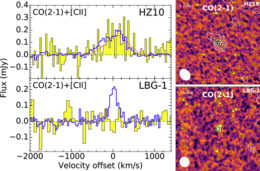Studying star formation in the early universe can give us clues about what the universe was like when the earliest massive galaxies were forming. How efficiently were these first galaxies making stars only a billion years after the Big Bang?
Lighting Up the Universe
The universe wasn’t always a treasure trove of galaxies. Not long after the Big Bang, it consisted largely of opaque neutral hydrogen, and the only photons present were either from the cosmic microwave background or emitted during electron transitions in hydrogen atoms. Between redshifts of z = 20 and z = 6 (i.e., between 150 million and 1 billion years after the Big Bang), the first galaxies formed and their stars ionized the hydrogen, allowing light to travel freely through the universe.
This sounds very neat and straightforward, but the specifics of this process are hazy (note the very large time window!). What sort of stars did the ionizing? Did it happen all at once or more slowly? How long did it take? Pinning down the star formation rates of galaxies at that transition redshift of z ~ 6 can help us answer some of these questions.

Left: spectra of galaxies HZ10 and LBG-1 highlighting the CO and carbon lines studied. The red line in the HZ10 spectrum is the Gaussian fit to the detected CO. The blue histogram is the CO emission, scaled down by a factor of 40. Right: integrated line maps of HZ10 and LBG-1 with contours showing CO (white lines) and carbon (black lines). The maps are created by integrating the individual spectra that compose the map, collapsing the data from three dimensions to two. The maps are scaled based on the carbon detections. [Pavesi et al. 2019]
And that’s precisely what a group of scientists led by Riccardo Pavesi (Cornell University) did. Using observations taken by the Very Large Array (VLA) and the Atacama Large Millimeter/submillimeter Array (ALMA), Pavesi and collaborators studied molecular features in a sample of galaxies at z = 5–6.
Reading the Lines
For this study, Pavesi and collaborators leverage particular emission lines associated with carbon monoxide (CO), carbon, and nitrogen. This emission can appear in long-wavelength observations when the galaxies in question are very distant. The authors also study the overall radiation emanating from dust in their target galaxies.
A notable finding from the analysis is the highest redshift detection of CO emission, which comes from a galaxy at z ~ 5.7. However, this galaxy, HZ10, also stands out for another reason: it appears to contain a large reservoir of gas, perfect for making stars.

The ratio of molecular gas mass to stellar mass versus redshift for galaxies located at 0 < z < 6, with the calculated masses based on CO measurements. Two galaxies from this study, HZ10 and LBG-1 are highlighted at the high redshift end of the plot, between z = 5 and z = 6. The gray line is a quadratic relation between mass ratio and redshift. The gray points are also HZ10 and LBG-1 with their mass ratios based on a different interpretation of the CO measurements. [Pavesi et al. 2019]
Star-ting and Stopping
The presence of unused star-making material so early in the universe is significant. Previous measurements of star formation at z > 5 found that early galaxies formed stars very efficiently — but because these studies probed only the most luminous of galaxies, it was unclear whether this result would hold for more typical galaxies at this redshift.
HZ10’s large gas reservoir indicates that this “normal” galaxy has a much lower star-formation efficiency than the brighter galaxies we’ve previously studied at this redshift; it actually shares more characteristics with galaxies at z ~ 3. HZ10 offers some of the first evidence that galaxies with lower star formation efficiencies exist at z > 3.
As with most new discoveries, we need larger samples and high quality observations to better understand this — stay tuned!
Citation
“Low Star Formation Efficiency in Typical Galaxies at z = 5–6,” Riccardo Pavesi et al 2019 ApJ 882 168. https://doi.org/10.3847/1538-4357/ab3a46


4 Comments
Pingback: From AAS NOVA: “Making Stars at the Beginning of the Universe” | sciencesprings
Pingback: Formando estrellas al principio del Universo – Observatori Astronòmic
Pingback: Formando estrellas al principio del Universo « SEDA / LIADA - RedLIADA - Cursos LIADA - Cielo del Mes - Fenómenos Astronómicos - RELEA
Pingback: Formando estrellas al principio del Universo « Sección de Astrofísica de la LIADA